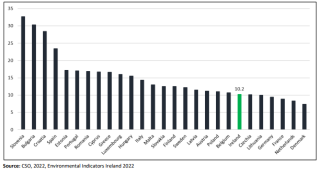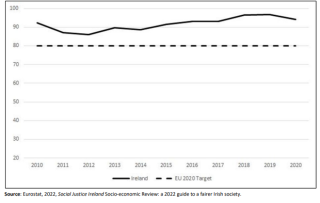Towards Wellbeing For All - Environment, Climate and Biodiversity

The Programme for Government acknowledged that our “existing measures of economic performance fail to measure matters such as damage to the environment and voluntary work. They also overlook equality of opportunity, distribution of wealth and income and only value public expenditure on the basis of the inputs used, not the outcomes achieved” and committed to introducing a series of indicators that would more accurately measure wellbeing to provide a “holistic view of how our society is faring”.
A ‘Wellbeing Dashboard’ was then developed to provide a snapshot of progress. In developing the Dashboard, the Inter-Departmental Working Group established a list of 35 indicators chosen to be balanced, add value or be of policy relevance, provide for aggregation and dis-aggregation, be readily available and of sufficient quality, and be internationally comparable.
So how are we doing? To gauge public opinion on what matters, and what should therefore be counted as an indicator of Well-being, Social Justice Ireland produced a survey asking people to rank a set of six indicators under each of the Well-being Framework dimensions from one to six, with one being the least important and six being the most important. The six indicators included the indicators used in the Dashboard and datasets readily available from the CSO and other reputable sources. This survey was circulated over the Summer months through our social media channels, our Weekly Digest, and our Members Bulletin. What follows is based on the responses to this survey and our policy proposals under each of the 11 dimensions.
Ireland’s fuel mix for electricity generation is still dominated by carbon-based fossil fuels, but the share of renewables is improving, reaching 42 per cent in 2020. However, Ireland is highly dependent on imported fossil fuels for energy, our import dependency was 72 per cent in 2020. This runs contrary to our targets of reducing emissions, increasing renewable energy, and eliminating our dependence on fossil fuels. In 2020 renewables made up 13 per cent of final energy consumption, well short of the 2020 target of 16 per cent. At a European level, Ireland ranks 7th from last for the share of renewable energy in gross final energy consumption.
In terms of biodiversity, Ireland has had the same number of Natura2000 sites (consisting of both Special Protected Areas (SPAs) under the EU Birds Directive and Special Areas of Conservation (SACs) under the EU Habitats Directive) between 2014 and 2019 (923,000 hectares). The common and farmland bird indices both improved between 2014 and 2019. While at a European level, Ireland had the fourth lowest proportion of total land area designated as terrestrial SPAs under the EU Birds Directive (at 6.2 per cent) and the eighth lowest rate of total land area designated as terrestrial Special Areas of Conservation (SACs) under the EU Habitats Directive at 10.2 per cent (Chart 1)
Chart 1: EU: Special areas of conservation 2020 under EU Habitats Directive

The proportion of the population unable to keep their home adequately warm decreased from 8.9 per cent in 2014 to 4.9 per cent in 2019. While not comparable due to a break in the time series, the proportion decreased slightly between 2020 and 2021 (from 3.3 to 3.2 per cent). In European terms, Ireland ranks 17th in terms of proportion of the population unable to keep the home adequately warm at less than half the EU-27 average.
Greenhouse gas emissions are also increasing (Chart 2) , by 1.7 million tonnes between 2014 and 2019 and are high by EU standards (second only to Luxembourg). While there was a short-term reduction in emissions because of restrictions on travel due to the pandemic, Ireland’s greenhouse gas emissions increased by 4.7 per cent in 2021 compared to 2020 and are now 1.1 per cent above 2019 pre-Covid 19 restriction levels.
Chart 2: Greenhouse Gas Emissions Ireland’s output versus Europe 2020 Target

Policy Priorities
- Fully resource the polices required to implement our 2030 climate targets.
- Integrate climate adaptation into the annual budgetary process. • Adopt targets and a reporting system for each of the Sustainable Development Goals.
- Review all fossil fuel subsidies and environmentally harmful tax expenditures annually with a view to removing those that do not align with our national climate goals.
- Introduce shadow national accounts, and assign value to natural capital and ecosystems in our national accounting systems.
- Fully resource the CSO to implement the System for EnvironmentalEconomic Accounts (SEEA).
- Develop a comprehensive mitigation and transition programme to support communities and people in the transition to a low carbon society.
- Develop a progressive and equitable environmental taxation system.
- Develop a new National Index of Progress encompassing environmental and social indicators of progress as well as economic ones.
- Develop a Just Transition Dialogue structure at regional and national level.